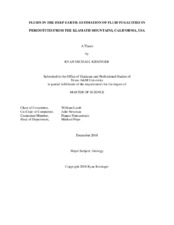| dc.description.abstract | Granulites-facies mineral assemblages typically require values of activity of Hv2O (aHv2O) significantly less than unity, and these values are reduced relative to lower grade rocks. Possible mechanisms for lowering values of aHv2O during granulite facies metamorphism include partial melting or infiltration of a low aHv2O fluid. For example, it has been argued that the infiltration of a large amount of COv2 could lower the aHv2O of rocks in the lower crust, and stabilize granulite-facies mineral assemblages. A third mechanism that could explain low values of aHv2O is the metamorphism of already dry rock.
The goal of this study is to evaluate granulite-forming mechanisms using peridotites from the Seiad Complex, Klamath Mountains, California. To accomplish this, we examined the nature of deep-seated fluids through the application of mineral equilibria, which are equations we used to quantify values of aHv2O and oxygen fugacity (fO2). A dehydration reaction involving amphibole, for example, yields values of aHv2O ranging from 0.3 to 0.5, and spinel equilibria yield estimates of fOv2 that range from -2 to 0 log units relative to the FMQ buffer. Calculation of fluid speciation in the C-O-H system indicates that values of fO2 recorded by some samples are inconsistent with a COv2 or CHv4-rich fluid. Furthermore, the presence of an Hv2O-rich fluid is inconsistent with values of aHv2O estimated using amphibole equilibria in these same rocks, which indicates there is no lithostatically pressured free fluid phase.
Clearly, the presence of amphibole in peridotites does not necessitate the presence of a Hv2O-rich free fluid phase, nor oxidizing values of fO2. The low values of aHv2O recorded by these rocks (< 0.5) are typical of granulite-facies metamorphism. If these rocks equilibrated at values of aHv2O that were less than 1 while in the mantle, similar to other mantle peridotites, then low values of aHv2O recorded during subsequent granulite-facies metamorphism are likely a result of the recrystallization of already dry rock rather than infiltration of externally derived fluids with low aHv2O or partial melting. | en |


